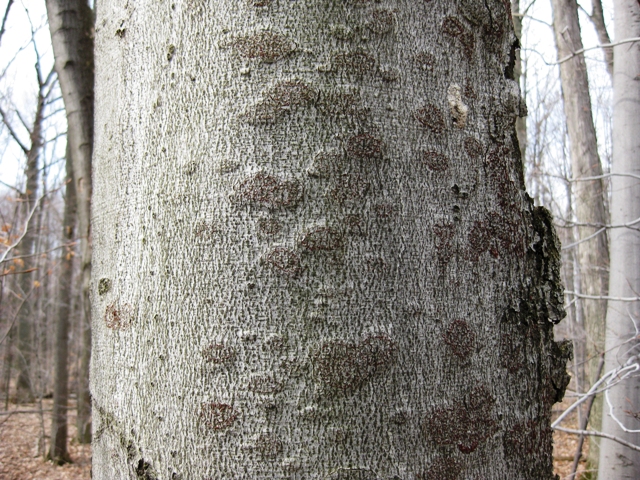Beech Bark Disease

Published in the 2019 Kawartha Lake Stewards Association Annual Report
Affected Tree Species: American Beech and European Beech
When it comes to beech bark disease, it’s a team effort between pest and disease. Still a relatively unknown issue in most of our province, the disease has been slowly killing beech trees in Canada and the United States from east to west for decades. In Ontario, the disease has been making the most impact in the eastern and southern forests.
Beech trees are large, shade tolerant deciduous trees found in rich mixed woodlands. They are most easily recognized by their smooth bark and are most commonly found alongside sugar maple, yellow birch and eastern hemlock. They are of ecological significance as their nuts are a source of food for bears and deer and the trees are an important home for birds and other wildlife.
The disease has two stages – first the tree is infested by an invasive scale insect, introduced from Europe, which are moved by wind, animals or by the movement of infected wood. These scale insects feed on the beech tree sap by creating tiny openings in the bark. The tiny openings then allow for the second stage of the disease, the colonization of a nectria fungus, which is thought to be native in North America and spread by wind and rain splash. This fungus causes cankers to form which cuts off the “veins” of the tree and cause the tree to die (see photo 2).
The disease appears to only effect beech trees over 8” in diameter and may not kill all trees that it infects, however trees are ultimately weakened making them susceptible to other stresses.
When inspecting beech trees look for trees that are thinning or yellowing in the upper canopy. Look for tiny (<1mm) wingless scale insects on the bark. After feeding, the scale covers themselves in a white, waxy coating that can be visible on the bark surface (see photo 3). Once the scale insect has created an opening in the bark and the fungus has infected the wound, fruiting bodies can be visible as deep orange-red, oval shaped marks seen on the bark in the late summer and fall (see photo 4). The fruiting bodies may also be identified as an oozing from the bark.
Removing diseased trees will help keep the fungus from further spreading, however the public is encouraged not to move the firewood which could unintentionally infect new stands of beech trees. If you notice a large healthy beech tree in a stand of diseased trees, please contact the Ministry of Natural Resources as this could show signs of disease resistance. Report all sightings of beech bark disease to the Invading Species Hotline at 1-800-563-7711 or report a sighting online through their website.

